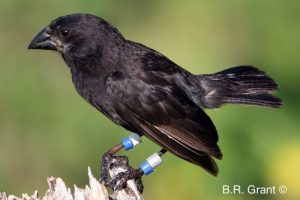Nov 24 2017
Evolution Observed in Darwin’s Finches
 Just two weeks ago I wrote about “Evolution Caught in the Act” – I was writing about fossils that are clearly transitional and occur within a major evolutionary change, like a land animal adapting to aquatic life. Now we have another report that justifies the same title, although this one is in living species.
Just two weeks ago I wrote about “Evolution Caught in the Act” – I was writing about fossils that are clearly transitional and occur within a major evolutionary change, like a land animal adapting to aquatic life. Now we have another report that justifies the same title, although this one is in living species.
For this observation we go back to the beginning, to the Galapagos where Darwin made observations critical to his development of evolutionary theory. The Galapagos are a chain is relatively young volcanic islands, far enough from the mainland to provide relative isolation, but close enough for life to find its way there. Most famously, some ancestral finch species found its way to the island. Their descendants then adapted to a variety of food sources, most obvious in the change in beak size and shape, optimized for its new use.
What Darwin observed is that the Galapagos finches filled many of the same niches as other bird families in other parts of the world. He had to puzzle out why on the Galapagos all those niches were filled by finches. He figured out that they must be descended from an ancestral finch, which also means that they have speciated into a large number of different finch species as they adapted to different islands and different food sources.
Modern evolutionary scientists have also capitalized on the unique natural experiment represented by the Galapagos. They have been closely observing the finches for decades, and this has provided a massive set of direct data. All this work has paid off in the observation of a chance speciation event.
Scientists report that in 1981 they observed the arrival of a male cactus finch (Geospiza conirostris), a non-native species, to the island of Daphne Major. The relatively large male mated with native female members of Geospiza fortis, a medium ground finch. They produced fertile young. In the 36 years since the descendants have produced a stable and isolated population (now about 30 individuals) – researchers all calling this the big bird population.
Importantly, this big bird population has remained completely genetically isolated from native populations (called “endogamous” – mating only within a group). The big bird population are larger than the native ground finches, and this has enabled them to exploit a new food source. Further, the native females do not seem to recognize the song of the big bird males, and so do not mate with them.
The one critical ingredient for speciation is genetic isolation. However, this direct observation documents the fact that isolation does not have to be geographical. Genetic isolation can occur in species that exist in the same physical location – which is called “sympatry”. This would therefore be an example of sympatric speciation.
Once populations are genetically isolated there are a number of processes that can make them diverge over time. Simple genetic drift may be enough – random and non-directed changes in gene frequency with occasional new mutations thrown in.
However, if the populations are under different selective pressures they will also demonstrate directed changes over time. That is the case here, as the larger big bird finches are exploiting a new niche.
In this case the researchers were expecting that the immigrant bird and his offspring would simply be absorbed into the native population. This can introduce new genes into the population, but would not establish a new species. They were surprised to find that the population remained genetically isolated. The mating habits of the finches, however, made this possible.
This, of course, is just one case, but it adds to other examples of population changes in living species. This is now one of the best cases of a speciation event observed in real time in a living species. I also shows how quirky evolution can be. Random events, like the chance migration of a single male finch 65 miles to a nearby island, can trigger evolutionary change. Further, there are many things that can genetically isolate populations, and simple behavior is one of them. Even very similar and fertile species can be genetically isolated by behavior, such as mating song.
It is cool that almost two centuries later the finches of the Galapagos are still teaching scientists about evolution.






